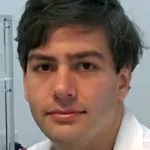
Screenshot from video by Tom Abate and Vignesh Ramachandran: Using time-lapse microscopy, Stanford bioengineer K.C. Huang and colleagues reveal how bacteria lose the cell walls that define their shapes, become less visible to the immune system, then revert to original form and regain full infectious potential.
Stanford Report - March 16th, 2015 - by Tom Abate and Chris Cesare
Sixty years ago, Nobel Prize-winning scientist Joshua Lederberg first described a biological mystery. He showed how bacteria could lose the cell walls that define their shapes, potentially becoming less visible to the immune system, only to later revert back to their original form and regain their full infectious potential.
Now, using time-lapse microscopy and other new techniques, Stanford bioengineering professor K.C. Huang and colleagues at Stanford and Princeton have created a forensic account detailing exactly how bacteria pull off this shape-shifting trick.
The experiments they describe in Molecular Microbiology now offer a step-by-step explanation of this curious behavior, and also shed light on one of the ways bacteria may develop antibiotic resistance.
Huang's team experimented with E. coli, one of the bacteria that can cause food poisoning. It's also a favorite of laboratory scientists, who have studied the organism for over 100 years.
Their experiments focused on the rigid cell wall that gives E. coli its characteristic rod-like shape.
In the wild, the cell wall exists to protect the bacterium, but it also send out signals that can alert our immune system to the presence of a potentially infectious intruder.
"A bacterial cell that's growing is also constantly shedding parts of its cell wall, similar to how a snake sheds its skin every so often," Huang said. "If a bacterium could get rid of its cell wall, it could effectively go undercover and avoid giving off the signals that its infected host might use to try to mount a response against this invader."
When the rigid cell wall is dissolved, the bacterium becomes a shapeless blob called an L-form.
In the 1950s, Lederberg, who later founded the genetics department at Stanford, showed that E. coli could survive for a time as L-forms and then recover their rod-like shapes in a process called reversion.
Huang's team created a molecular-level understanding of the process that Lederberg first observed. They used high-resolution microscopes to record time-lapse images of rod-shaped E. coli cells becoming L-form blobs and then reverting to rod-shaped again.
Follow the proteins
E. coli's cell wall is knitted together by proteins, a class of molecules that work together to perform many biological functions.
"It's like an orchestra in which several proteins perform different roles required to build the cell wall," Huang said.
Previous research has shown that one protein, MreB, acts like the conductor, coordinating the efforts of several other proteins.
But those studies focused on normal, rod-shaped E. coli. In this experiment, Huang's team wanted to understand how MreB factored into the process by which L-forms reverted back to normal.
"We had a suspicion that as the conductor of this orchestra during regular growth, MreB might also be critical for reversion," Huang said.
Growing L-forms
Under the tireless gaze of their time-lapse microscope, the researchers grew E. coli cells dosed with the antibiotic cefsulodin. A relative of penicillin, cefsulodin prevents E. coli from building cell walls.
The cefsulodin did not kill the E. coli, but as the cells divided and created successive generations, the bacteria lost their rod-shaped walls and became blob-like L-forms.
The bioengineers let the L-forms grow and reproduce for a few hours before flushing out the cefsulodin. All the while they kept these blobs under microscopic surveillance. As the cells continued to reproduce, the time-lapse images showed that later generations slowly regained their rod-like shape.
That experiment documented the process of reversion to standard form. But it did not prove that MreB was essential.
To demonstrate the link between the rod shape and MreB, the engineers performed a variation on this experiment.
After adding cefsulodin and letting the rod-shaped E. coli reproduce to become shapeless L-forms, they once again flushed out the antibiotic.
But this time, they added a different antibiotic that specifically suppressed MreB function.
Two hours later, the cell walls returned, as a rigid structure protecting the cell.
But this time the cells were still shaped like blobs, and eventually all of these misshapen cells died.
"What we found was very stark: MreB was critical for this reversion process to occur, and without MreB what would happen is that the cells would just expand in size without any notion of their normal shape," Huang said.
In addition to offering fundamental insights into how cells maintain their structures, Huang said the findings could help researchers understand how some bacteria adapt to stressful environments.
Many antibiotics, including penicillin, target the cell wall. But bacteria can lose their cell walls and then later recover their shapes. This process of reversion might explain how bacteria develop resistance to bacteria and establish chronic infections. The populations that survive in L-form and revert to their original shape may not be as susceptible to the next dose of antibiotics.
"Better understanding of cell wall construction could lead to better antibiotic strategies," Huang said. "And I'm always amazed to discover ways in which biology is programmed so robustly."


